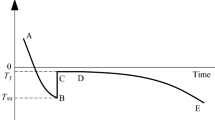Abstract
Owing to the temperature, the migration and redistribution of soil water and heat during the freezing process are important factors affecting the spring waterlogging disaster in the permafrost area. In order to quantitatively analyze the effects of low freezing temperatures and initial soil water content on soil water and heat redistribution and their change rates, this study conducted indoor unidirectional closed freezing tests under different initial conditions, setting freezing temperatures (-20 ℃, -25 ℃, -35 ℃) and initial soil water content (12%, 22%, 32%). During the freezing process, we monitored the water and temperature of the silty sand column as well as quantitatively analyzed the influence of freezing temperature and initial soil water content on reaching stable freezing temperature, temperature reduction rate, unfrozen water content, and change rate of unfrozen water content at lower temperatures. Additionally, we summarized the change trend of various indicators with time and depth. The results showed that the freezing temperature and initial water content had significant effects on the shallow soil temperature and water content changes, and the effect gradually weakened with increasing depth. The lower the freezing temperature, the lower the initial water content, the shallower the depth, the shorter the time for the soil temperature field to reach stability, and the larger the temperature drop rate. At freezing temperatures, there is always some amount of unfrozen water that remains stable. The lower the freezing temperature, the shallower the depth, the lower the unfrozen water content, and the greater the change rate of unfrozen water content after freezing stabilization. The initial water content has little influence on the content of unfrozen water after freezing but has a significant influence on the rate of change of the unfrozen water content. The higher the initial water content, the greater the change rate of the unfrozen water content, and the faster the water migration. The research results are of great significance for understanding the internal laws between water content, temperature, and depth of frozen soil as well as for guiding the development and utilization of soil and soil resources in cold areas in the future.











Similar content being viewed by others
References
Dahu Rui, Jinbang Zhai, Guoyu Li et al (2019) Field experimental study of the characteristics of heat and water transfer during frost heaving. Cold Reg Sci Technol 168:102892
Dirksen C, Miller RD (1965) Closed-system Freezing of Unsaturated Soil[M]. Soil Science Society of America, New York, pp 67–80
Hoekstra P (1966) Moisture movement in soil under temperature gradients with cold side temperature below freezing[J]. Water Resour Res 2(2):241–250
Kay BD, Fuked M et al (1981) The importance of water migration in the measurements of the thermal conductivity of unsaturated frozen soil[J]. Cold Region Sci and Tech 5:95–106
Li G, Tiande M (1998) Thermodynamic model of heat-moisture migration in saturated freezing soil[J]. Chin J Geotech Eng 20(5):87–91
Libo S, Xiaomin C, Xinxiao Y et al (2021) Effect of freeze-thaw processes on soil water transport of farmland in a semi-arid area[J]. Agric Water Manag 252:106876
Mao X, Miller C, Hou Z et al (2014) Experimental Study of Soil Water Migration in Freezing Process[J]. Geotech Test J 37(3):436–446
Wu Mousong (2016) Water, heat and solute transport in frozen soil: experimental and modeling study[D]. Wuhan University
Nassar IN, Robert H (1992) Simultaneous transfer of heat, water, and solute in porous media: I, Theoretical development [J]. Soil Sci Soc Am J 56:1350–1356
Nassar IN, Globus AM, Robert H (1992) Simultaneous transfer of heat, water, and solute in porous media: II. Experiment and analysis [J]. Soil Sci. Soc Am J 56:1357–1365
Qiang Fu, Ruiqi J, Zilong W et al (2015) Soil moisture movement during freezing-thawing period under different snow covers[J]. Transactions of the Chinese Society for Agricultural Machinery 46(10):152–159
Ran HW, Fan JH, Huang J (2019) Review of the coupling of water and heat in the freeze-thaw process and its model of frozen soil[J]. Pratacultural Sci 36(04):991–999
Renjie Hou, Qiang LiTianxiao Fu et al (2019) Characteristics of water–heat variation and the transfer relationship in sandy loam under different conditions. Geoderma 340:259–268
Renjie Hou, Li Tianxiao Fu, Qiang, et al (2020) Research on the distribution of soil water, heat, salt and their response mechanisms under freezing conditions. Soil and Tillage Res 196:104486
Ruixia He, Huijun J, Shuping Z et al (2018) Review of status and progress of the study in thermal conductivity of frozen soil. J Glaciol Geocryol 40(01):116–126
Taylor GS, Luthin N (1978) A model for coupled heat and moisture transfer during soil freezing[J]. Can Geo J 15:548–555
Tiande M, Li G, Yonghong N (1999) Mixture theoretical model for water and heat transfer in permafrost[J]. Science in China (series d) 29(1):8–14
Xinchun L, Yongde K, Hongna C et al (2021) Hydrothermal Effects of Freeze-Thaw in the Taklimakan Desert[J]. Sustainability 13:1292
Xuezu Xu, Yousheng D (1991) Experimental study on water transport in frozen soil [M]. Science Press, Beijing
Peng Zhenyang (2015) Mechanism and modeling of coupled water-heat-solute movement in unidirectional freezing soils[D]. Wuhan University
Чьлтoвич HA (1985) Frozen soil mechanics [M]. Science Press, Beijing
Funding
We are grateful to Project UNPYSCT-2020012 Supported by University Nursing Program for Young Scholars with Creative Talents in Heilongjiang Province for financial supports.
Author information
Authors and Affiliations
Corresponding author
Ethics declarations
Conflicts of Interest
All authors certify that they have no affiliations with or involvement in any organization or entity with any financial interest or non-financial interest in the subject matter or materials discussed in this manuscript.
Additional information
Responsible Editor: Broder J. Merkel
Rights and permissions
About this article
Cite this article
Mo, C., Hanbing, C. & Anyu, L. Effect of freezing temperature and initial water content on hydrothermal migration of silty soil under freezing. Arab J Geosci 15, 207 (2022). https://doi.org/10.1007/s12517-022-09486-5
Received:
Accepted:
Published:
DOI: https://doi.org/10.1007/s12517-022-09486-5




